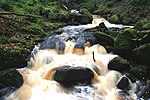Padley Chapel
Grade I listed Roman Catholic churches in EnglandGrade I listed buildings in DerbyshireRoman Catholic Diocese of HallamRoman Catholic churches in DerbyshireRoman Catholic shrines in the United Kingdom ... and 1 more
Scheduled monuments in Derbyshire

Padley Chapel is a building in Grindleford, England, on the site of the former Padley Hall (or Padley Manor). It is a Grade I listed building.
Excerpt from the Wikipedia article Padley Chapel (License: CC BY-SA 3.0, Authors, Images).Padley Chapel
Main Road, Derbyshire Dales
Geographical coordinates (GPS) Address External links Nearby Places Show on map
Geographical coordinates (GPS)
| Latitude | Longitude |
|---|---|
| N 53.307 ° | E -1.6311 ° |
Address
Padley Chapel
Main Road
S32 2HE Derbyshire Dales
England, United Kingdom
Open on Google Maps










